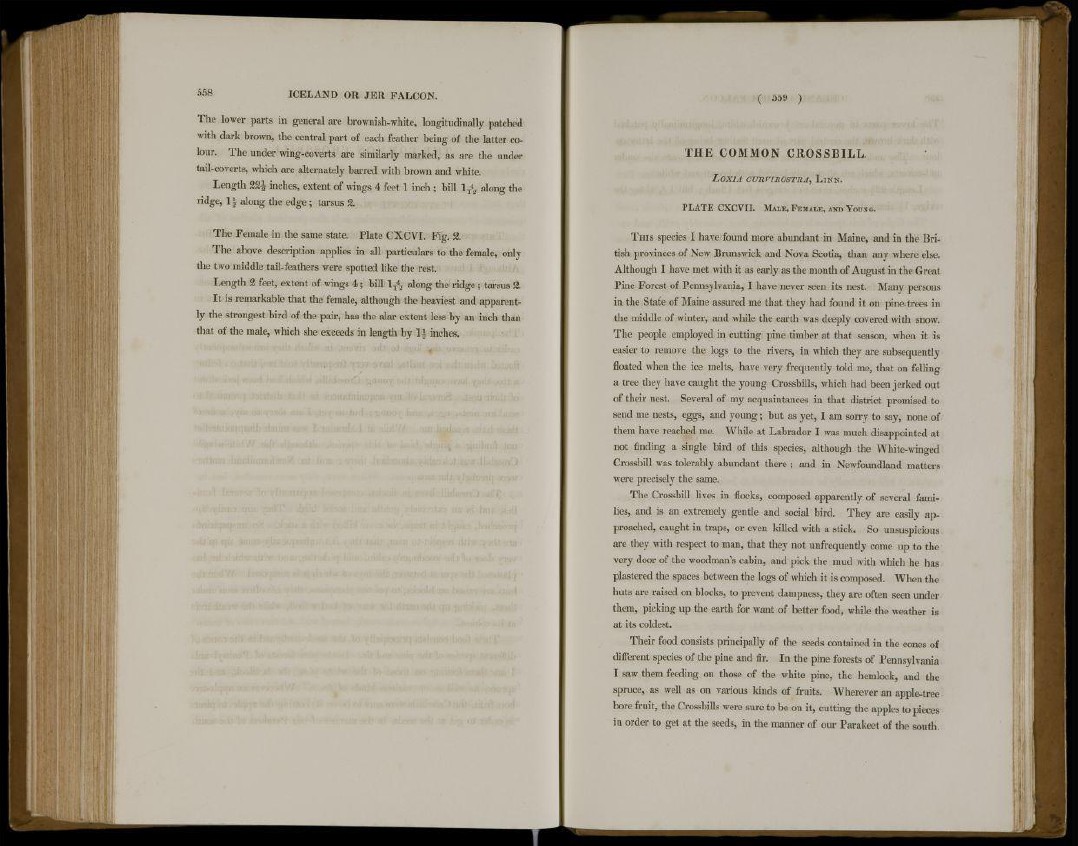
558 ICELAND OR JER FALCON.
The lower parts in general are brownish-white, longitudinally patched
with dark brown, the central part of each feather being of the latter colour.
The under wing-coverts are similarly marked, as are the under
tail-coverts, which are alternately barred with brown and white.
Length 22^ inches, extent of wings 4 feet 1 inch ; bill 1 T
4
? along the
ridge, 1 \ along the edge ; tarsus 2.
The Female in the same state. Plate CXCVI. Fig. 2.
The above description applies in all particulars to the female, only
the two middle tail-feathers were spotted like the rest.
Length 2 feet, extent of wings 4 ; bill \T% along the ridge ; tarsus 2.
It is remarkable that the female, although the heaviest and apparently
the strongest bird of the pair, has the alar extent less by an inch than
that of the male, which she exceeds in length by 1£ inches.
( 559 )
T H E COMMON CROSSBILL.
LOXIA CURVIROSTRA, LlNN.
P L A T E C X C V I I . MALE, FEMALE, AND YOUNG.
THIS species I have found more abundant in Maine, and in the British
provinces of New Brunswick and Nova Scotia, than any where else.
Although I have met with it as early as the month of August in the Great
Pine Forest of Pennsylvania, I have never seen its nest. Many persons
in the State of Maine assured me that they had found it on pine-trees in
the middle of winter, and while the earth was deeply covered with snow.
The people employed in cutting pine timber at that season, when it is
easier to remove the logs to the rivers, in which they are subsequently
floated when the ice melts, have very frequently told me, that on felling
a tree they have caught the young Crossbills, which had been jerked out
of their nest. Several of my acquaintances in that district promised to
send me nests, eggs, and young ; but as yet, I am sorry to say, none of
them have reached me. While at Labrador I was much disappointed at
not finding a single bird of this species, although the White-winged
Crossbill was tolerably abundant there ; and in Newfoundland matters
were precisely the same.
The Crossbill lives in flocks, composed apparently of several families,
and is an extremely gentle and social bird. They are easily approached,
caught in traps, or even killed with a stick. So unsuspicious
are they with respect to man, that they not unfrequently come up to the
very door of the woodman's cabin, and pick the mud with which he has
plastered the spaces between the logs of which it is composed. When the
huts are raised on blocks, to prevent dampness, they are often seen under
them, picking up the earth for want of better food, while the weather is
at its coldest.
Their food consists principally of the seeds contained in the cones of
different species of the pine and fir. In the pine forests of Pennsylvania
I saw them feeding on those of the white pine, the hemlock, and the
spruce, as well as on various kinds of fruits. Wherever an apple-tree
bore fruit, the Crossbills were sure to be on it, cutting the apples to pieces
in order to get at the seeds, in the manner of our Parakeet of the south.